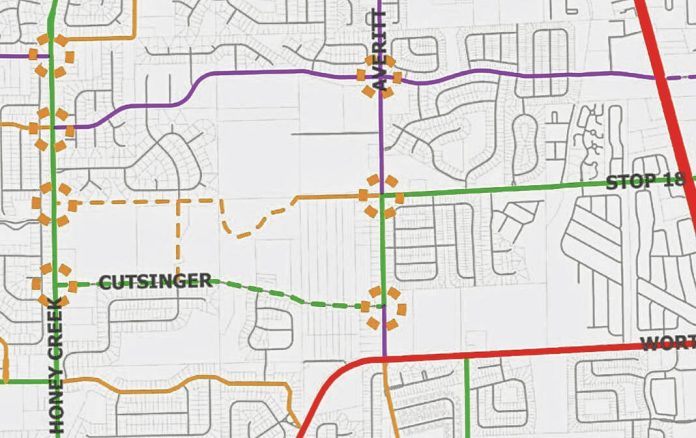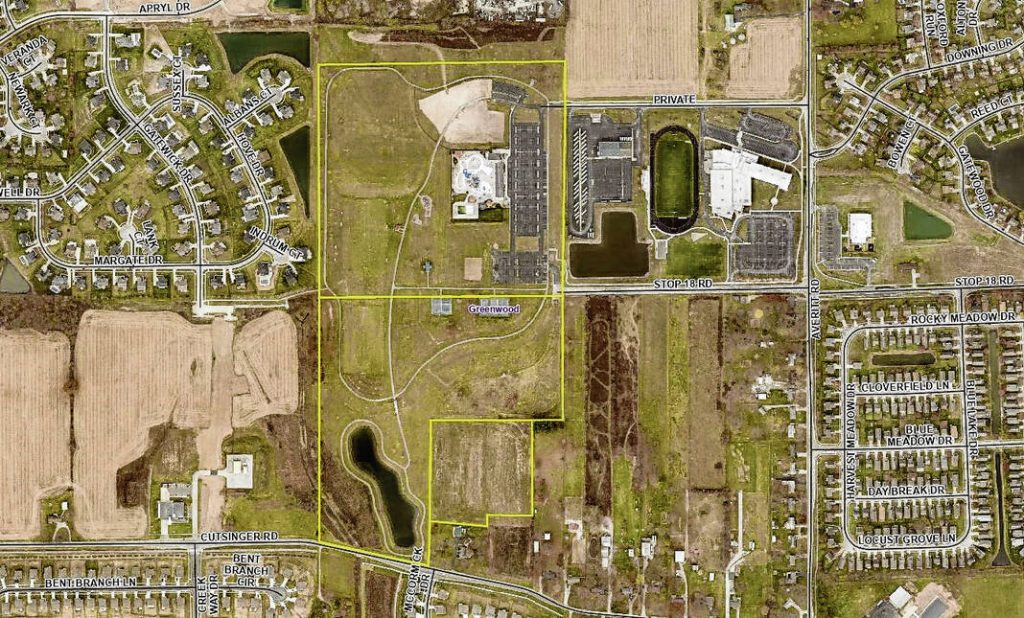
An extension of Stop 18 Road through Freedom Park, seen as the orange dashed line that curves near the center, identified in the Greenwood’s comprehensive plan is sparking ire among nearby residents. Provided by the city of Greenwood
Greenwood’s comprehensive plan is moving closer to final adoption despite concerns from residents about a potential road extension through Freedom Park.
The Greenwood Advisory Plan Commission voted 7-0, with members David Lekse and Charrie Stambaugh absent, to give a favorable recommendation for approval of the city’s amended and updated comprehensive plan. For over a year, officials have been creating a new comprehensive plan, which will guide development and growth in the city for the next 10 to 20 years. The full plan was last updated in 2007, and while there have been some smaller updates since then, it does not account for all of the growth the city has seen over the last 20 years.
Throughout the process, the city and consultant HWC Engineering have held several public meetings about the plan to encourage public feedback. Residents have responded throughout the process. In recent months the focus has turned to an extension of Stop 18 Road through Freedom Park, which officials have identified as a potential need in plans as far back as 1988. The goal is to add another connection to Freedom Park for residents west of the park.
While there are no immediate plans for this, nearby residents are concerned about its inclusion. Several residents have disagreed with it, voicing opposition and asking the city to consider alternatives.
The plan
The 285-page “adoption draft” identifies several key themes for the city’s future growth, redevelopment and investment, which were categorized based on the city’s “Four Pillars” — public safety, infrastructure, economic development and quality of life, along with land use.
For infrastructure, planners suggest officials use planned road improvements and extensions to manage development. It is also suggested officials work to address safety and congestion concerns, which came up frequently in community feedback, and to use new development to expand vehicular, bicycle and pedestrian connectivity.
For quality of life, city officials are being encouraged to grow recreational opportunities through new parks and expanded trails and maintain Old Town and established neighborhoods as foundations of the community, according to the plan’s draft.
As for public safety, the plan says the city should continue to grow emergency services alongside new developments and improve communications between city staff, residents and regional partners.
Additionally, six areas were identified as areas for redevelopment and investment — Old Town, the Greenwood Park Mall, Airport Parkway between Main Street and County Line Road, Main Street east of Interstate 65, the Main Street I-65 interchange and Worthsville Road east of I-65.
Since a draft was first unveiled in July, there have not been many substantial changes. Several of the changes made had to do with the choice of colors on the map, said Adam Peaper, a community planner with HWC Engineering and the project manager for Greenwood’s plan.
Other tweaks were to include photos from winners of a contest the city held, adding more information for action plans and updating the trail system map to acknowledge some existing infrastructure. HWC also added additional pedestrian facilities and crossing recommendations, Peaper said.
An emergency sirens map was also added, showing where the city’s current storm sirens are and their range. The same map also identifies where new sirens could be added and their range.

Concerns raised
Four residents spoke during the public hearing for the plan, each expressing concern about the proposed Stop 18 extension identified within it.
James Workman, who said he represents a group of concerned residents, told the commission residents like the overall plan but are against the proposed extension. Workman asked for it to be removed.
“This connection, it would effectively split the park in half because you have a road running through the middle of it,” Workman said. “We recognize that the objections to this, again, have occurred, and despite feedback that still remains in the plan.”
While officials have said it’s been in past plans, it doesn’t mean the extension is still desirable or required, he said. Residents were not aware of any request or demand that would necessitate the extension, Workman said.
Among the concerns residents have about the Stop 18 Road extension are safety, the environment, the necessity and the exploration of alternatives, he said.
The proposed road would snake through the park, going past soccer fields and existing homes. This could create potential safety issues, said Ron DeTar, another resident.
Kids could be playing in the park and a ball could roll into the road, DeTar said. They could chase after it into the road, running the risk of being injured by a car, DeTar implied, which could go against the comprehensive plan’s goals for safety.
DeTar also argued it would make the park less peaceful. Even if speed bumps were put in, people could use the road as a race track, he said.
He also implied it could increase crime and would increase costs by requiring more police patrols.
“The comprehensive plan is supposed to reflect the will of the citizens, and throughout this whole process, there’s a lot of citizens who have spoken out against this one particular issue and it’s still in the plan,” DeTar said.
Doug Walden, a Brighton Estates resident, told the commission there are already east-west roads nearby, like Cutsinger Road and Apryl Drive, along with alternate roads that connect Honey Creek and Averitt roads. Brighton Estates is located to the immediate west of Freedom Park, and the proposed road would connect to the subdivision.
A path from Honey Creek Road to Freedom Park could accomplish better access to the park from the west without building a new road, Walden argued. He cited roundabouts at Cutsinger and Averitt roads and Cutsinger and Honey Creek roads, which are identified as potential road improvements in the plan, as ways to improve east-west traffic flows.
Patrick Chambers, another Brighton Estates resident, told the commission he understood the reasoning for adding the road, but asked them to consider alternatives, he said.
The city could have a multipurpose trail or bike path instead of a full road. They could also make a walking path from near Greenwood Fire Station 93 on Cutsinger Road and have it go into the park, Chambers said.
A shared-use pathway could also be constructed into Brighton Knoll, an under-construction subdivision to the north, Chambers suggested.
Officials respond
The comprehensive plan is a long-range guide with “very high level” recommendations, Peaper said. Additional study and engineering would be needed to implement the recommendations, he said. This includes the extension.
Officials have already lowered the road’s classification from past plans to make it have less traffic. They’ve kept it in the latest plan because it’s in past plans, and because part of the infrastructure is partially built, Peaper said. For example, a pedestrian bridge already exists where a road would be built in the park.
Since 1988, the road’s plans have changed to make it curve through the park. This is done so the parks department could “activate” different areas of the park, including building additional parking lots off the road, said Gabe Nelson, the city’s planning director.
Throughout the process, city officials have responded to the concerns by saying the extension, if built, would be to accommodate the future growth of Freedom Park. Parks officials want to add more amenities to the park in the long-term, transforming it from a neighborhood park to a regional park, Nelson said.
If a road is built, it would be laid 30 feet away from the existing multi-use path, Nelson said. It would also have speed mitigation features built in, though because it has not been fully designed, those features are still to be determined.
At least one resident disagreed with the characterization that the park is underutilized. It’s one thing if officials want to have more parking, but putting another road could lead to “a lot more” accidents, DeTar said.
Workman also spoke out during the rebuttal, saying officials were adding risk to something that has zero risk now.
Plan commission members John Shell and Brian Walker both said it was their understanding the parks department wants more access to the park, with Shell adding the department was excited to have more parking in the future.
Commission member Michael Probst, who is also a park’s department representative, said the department is hiring a consultant to look at the park’s future uses. The department will do what’s best for the community, Probst said, citing what he discussed with department leadership.
Residents feel ignored
With the plan commission’s favorable recommendation, the amended plan goes next to the city council for adoption. It will be introduced on Sept. 16, followed by two readings at subsequent meetings, Nelson said. This could be expedited if the council suspends the rules to push it through to a final vote that night.
The concerned residents plan to continue to voice their displeasure with the extension’s inclusion, several residents told the Daily Journal after the hearing. This includes going to upcoming city council meetings to voice their opposition to the extension, and possibly the plan as a whole, they said.
These residents also said they felt ignored and dismissed by city officials. They again emphasized there are alternatives to the road extension.
DeTar later cited a quote from an opinion article published in the Daily Journal earlier this month, which was about how there was no evidence for the adage of “being tough on crime,” to describe residents’ frustration with the city.
“’Standing for something shouldn’t require sticking with the same policy year after year expecting a positive result despite overwhelming evidence to the contrary. Some would say this is the definition of insanity,’” DeTar said via email quoting an opinion piece by Zach Stock that published Sept. 5.




